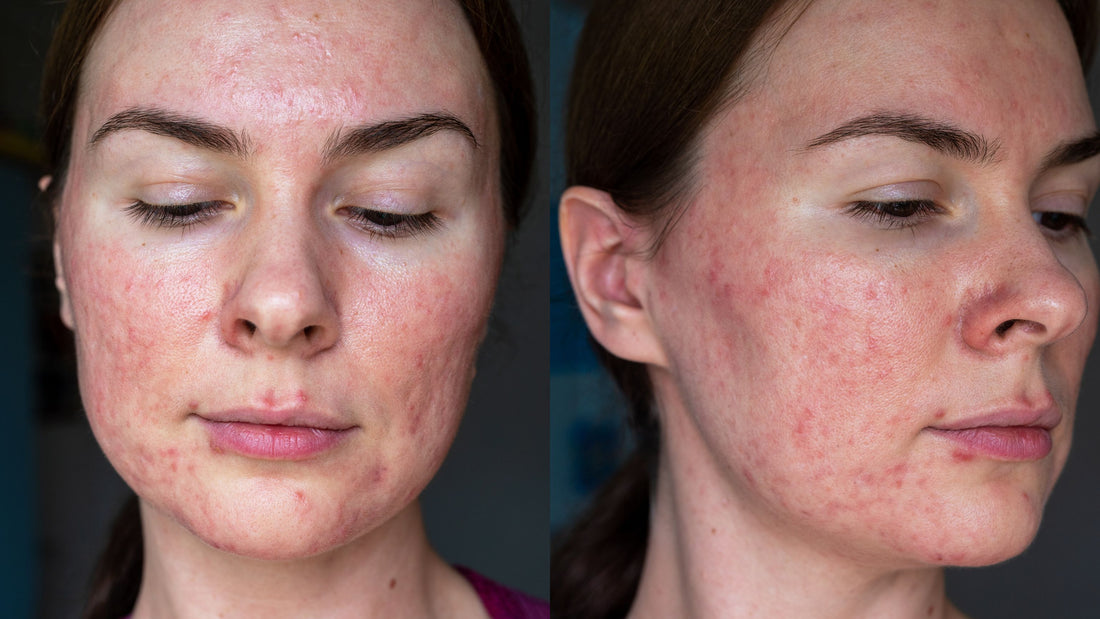
What is Papulopustular Rosacea?
Share
Living with papulopustular rosacea can be difficult, both physically and emotionally. This prevalent skin disorder affects millions of people worldwide, resulting in chronic redness, acne-like pimples, and pus-filled lesions on the face. Coping with the outward signs of papulopustular rosacea can have a negative impact on one's self-confidence. In this blog, we will look at the symptoms, causes, and treatment options for papulopustular rosacea, providing guidance and support for those dealing with this condition.
What is Papulopustular Rosacea?
Papulopustular rosacea is a subtype of rosacea, a chronic inflammatory skin condition affecting mostly the face. Unlike other types of rosacea, which can cause flushing, visible blood vessels (telangiectasia), and skin thickening (phymatous alterations), papulopustular rosacea is distinguished by acne-like pimples (papules) and pus-filled lesions (pustules). These lesions frequently occur in the central areas of the face, including the cheeks, nose, chin, and forehead.
Symptoms of Papulopustular Rosacea:
The main symptoms of papulopustular rosacea are:
- Persistent facial redness, often resembling a sunburn or blush
- Acne-like bumps (papules) and pus-filled lesions (pustules)
- Sensitive or burning sensation on the skin
- Flare-ups triggered by various factors such as heat, sunlight, stress, spicy foods, alcohol, and certain skincare products
Causes and Triggers:
The specific cause of papulopustular rosacea is unknown, however various factors may contribute to its onset and worsening. This includes:
- Abnormalities in the immune system and inflammatory response
- Genetic predisposition
- Dysfunction of the skin barrier
- Demodex mites living on the skin
- Environmental factors such as sunlight, heat, wind, and humidity
- Emotional stress
- Certain foods and beverages, particularly spicy foods and alcohol
- Skincare products containing irritants or harsh ingredients
Diagnosis:
Papulopustular rosacea is normally diagnosed after a thorough examination of the skin by a dermatologist or healthcare expert. The presence of distinctive symptoms such as facial redness, papules, and pustules, as well as a history of flushing and sensitivity, aids in the differentiation from other skin disorders. In some circumstances, additional testing may be required to rule out other illnesses causing similar symptoms.
Treatment Options:
While there is no cure for papulopustular rosacea, there are several treatment options that can help manage the symptoms and decrease flare-ups. This may include:
- Topical medications: Prescription creams or gels containing ingredients such as azelaic acid, metronidazole, or sulfur can help reduce inflammation and improve the appearance of papules and pustules.
- Oral antibiotics: Antibiotics such as doxycycline, minocycline, or erythromycin may be prescribed to control the bacterial component of rosacea and reduce inflammation.
- Oral anti-inflammatory medications: In some cases, oral medications such as isotretinoin or low-dose oral steroids may be used to control severe inflammation and breakouts.
- Skincare modifications: Avoiding harsh cleansers, exfoliants, and irritants can help prevent irritation and reduce flare-ups. Gentle skincare products formulated for sensitive skin are often recommended.
- Lifestyle changes: Identifying and avoiding triggers such as sunlight, heat, spicy foods, alcohol, and stress can help minimize flare-ups and improve symptom management.
- Laser and light therapies: Procedures such as intense pulsed light (IPL) therapy or laser therapy may help reduce redness, visible blood vessels, and inflammation associated with rosacea.
Self-Care and Management Strategies:
In addition to medicinal therapies, self-care measures can help manage papulopustular rosacea. This may include:
- Protecting the skin from sunlight by wearing broad-spectrum sunscreen and protective clothing
- Avoiding extreme temperatures and environmental triggers
- Practicing stress-reduction techniques such as mindfulness, meditation, or yoga
- Keeping a diary to identify and avoid personal triggers
- Following a gentle skincare routine using non-irritating products
- Seeking support from healthcare professionals, support groups, or online communities for coping with the emotional impact of rosacea
Overcoming the Struggles of Papulopustular Rosacea
Papulopustular rosacea can have a substantial influence on a person's quality of life, but with proper diagnosis and management, the symptoms can be effectively managed. Individuals suffering from papulopustular rosacea can reduce flare-ups and achieve clearer, healthier skin by knowing the triggers, obtaining appropriate medical therapy, and using self-care measures.
